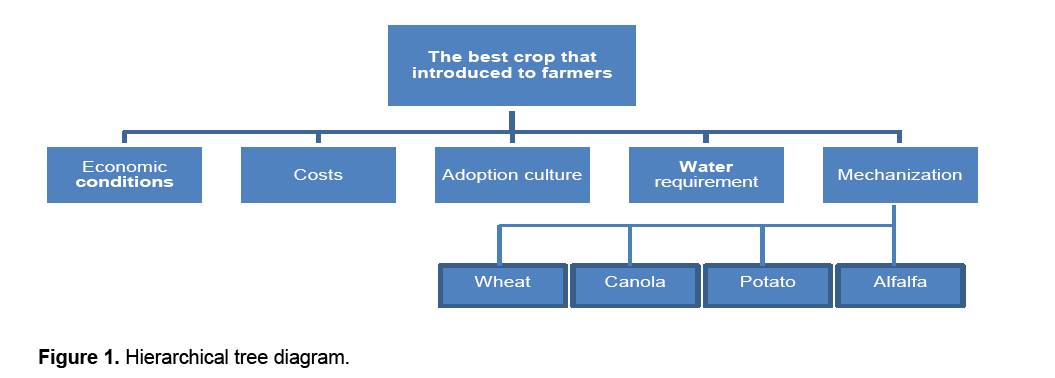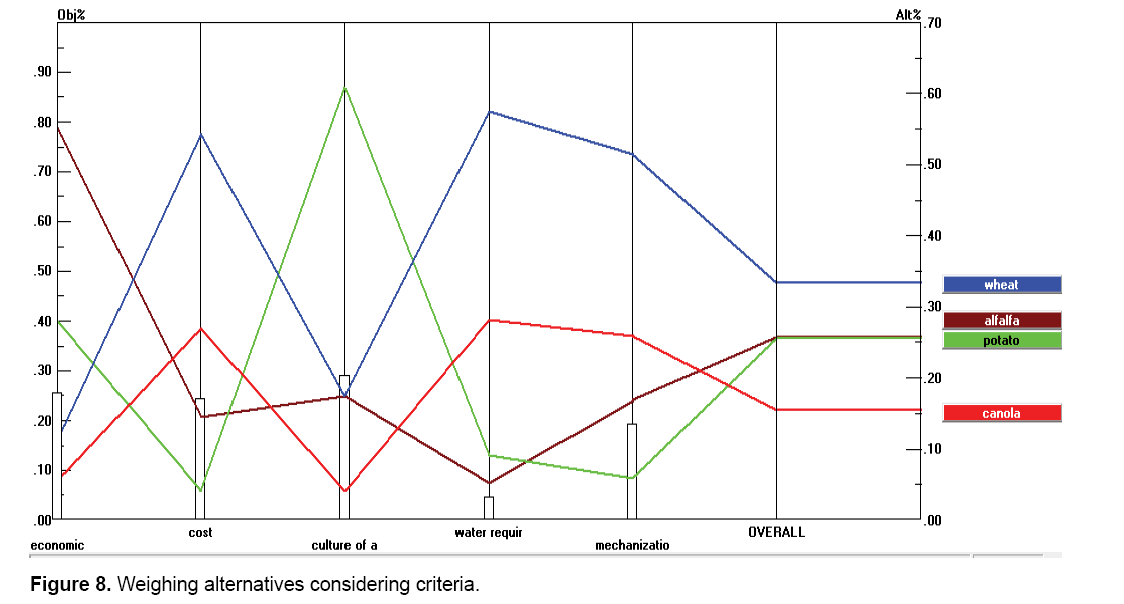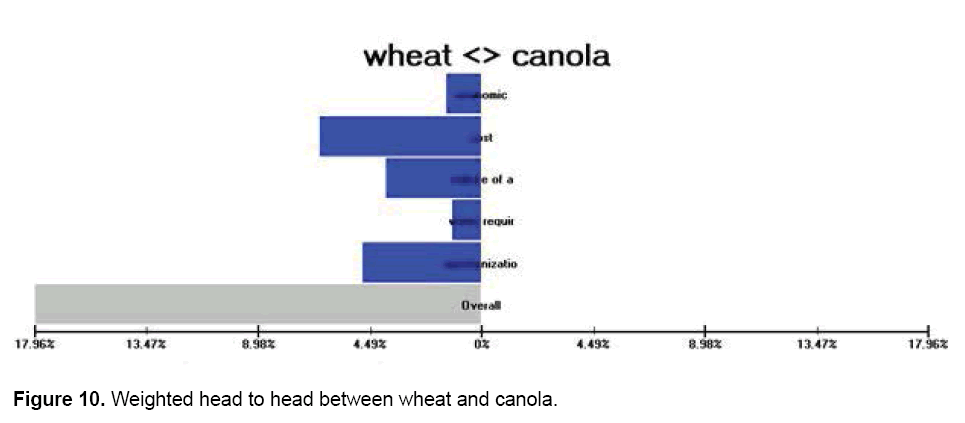Designing Cropping Pattern by Using Analytical Hierarchy Process to Allow For Optimal Exploitation of Water
Sh. Hassani, M. Ramroodi, M. Naghashzadeh
Sh. Hassani1,*, M Ramroodi2, M Naghashzadeh3
1 PhD Student of Agroecology, Zabol University, Zabol, Iran;
2 Associate Professor of Agroecology, Zabol University, Zabol, Iran;
3 PhD of agronomy, Organization of Agricultural Jihad Lorestan, Khorramabad, Iran.
- Corresponding Author:
- Sh. Hassani
PhD Student of Agroecology
Zabol University, Zabol, Iran
Tel: +98 (0) 916 360 5947
E-mail: shahin.hassani45@gmail.com
Received date: December 17, 2015; Accepted date: January 22, 2016; Published date: January 31, 2016
Citation: Hassani S, Ramroodi M, Naghashzadeh M, Designing Cropping Pattern by Using Analytical Hierarchy Process to Allow for Optimal Exploitation of Water. Electronic J Biol, 12:1
Abstract
Cropping pattern is one of the most important parameters for conducting appropriate rotation, so that it will be directly related to optimal exploitation of water and soil resources. Cropping pattern varies considerably in different regions with various conditions and each region has various criteria. In order to determine optimal cropping pattern this study was conducted by analytical hierarchy process (AHP) because of preventing watermelon planting with high water requirement in summer without rainfall. The selected criteria comprised economic conditions (farmer incomes), costs (relative to crop production costs), water requirement, adoption culture of native farmers and mechanization. According to mentioned criteria, irrigated wheat, canola, potato and alfalfa were selected. Field studies and information were obtained by 15 questionnaires and 14 leading farmers. The results showed that suggested cropping pattern in order of priority was wheat>potato=alfalfa>canola.
Keywords
Analytical hierarchy process; Cropping pattern; Wheat; Potato; Alfalfa; Canola.
Introduction
Many crops can be produced in Zagheh district weather conditions, especially in summer by using groundwater. Thus, farmers switch to crops with high water requirement (e.g. watermelon). Although irrigated lands are about 25% of total farmland, dryland areas are irrigated by tube wells and water is pumped to long distances (25%). This leads to overuse aquifer and drawdown of water table. Unfortunately, watermelon and potato are dominated in this region so that both cannot eliminate and thus with omitting watermelon, cropping pattern was designed in this study.
On the one hand, water deficit and drought are the most serious obstacles to agricultural production. On the other hand, farmers look for maximum profit that is in stark contrast to optimal exploitation of water resources. In view of adoption culture and income native farmers and using expert opinion, cropping pattern should be changed to cultivate watermelon. For this purpose AHP method was applied – “The Analytic Hierarchy Process (AHP) is a method of measurement through pairwise comparisons and relies on the judgments of experts to derive priority scales. It has been one of the most widely used multiple criteria decision-making tools. It is used by decision makers and researchers, because it is a simple and powerful tool” [1].
On the subject of AHP method many studies have been conducted that included “decision model for facility location selection” [2], “municipal solid waste landfill site selection” [3], “model for crop planning within irrigation command areas” [4], “an integrated method using the analytical hierarchy process with goal programming for multiple sourcing with discounted prices” [5], “multi-criteria decision analysis in spatial decision support: the assess analytic hierarchy process and the role of quantitative methods and spatially explicit analysis” [6], “application of the AHP methodology in making proposal for a public work contract” [7].
The aim of this study was to design cropping pattern relative to cultural, economic and climatic conditions by using analytical hierarchy process to allow for optimal exploitation of water.
Materials and Methods
The hierarchical tree diagram
Goal: Main question or problem that should be solved. The goal, in this study, was the best crop that introduced to farmers considering conditions and determined criteria in order of priority.
Criteria: A group of factors or criteria that relate the alternatives to the goal. The criteria, in this project, comprised:
• Economic conditions–farmer income.
• Costs–costs related to farm operations.
• Adoption culture–awareness of farmers with regard to crop.
• Water requirement–coinciding peak water demand with rainfall and overflowing rivers.
• Mechanization–planting, tillage and machinery operations that should be needed in the region.
Alternatives: The final step of the process that answer for question of goal. The alternatives, in this research, included wheat, canola, potato and alfalfa. After determining goal, criteria and alternatives, the hierarchical tree diagram was plotted (Figure 1). The alternative levels were plotted for each criterion– in this diagram, the lines were only plotted for mechanization because of frequent lines.
Data collection
For collecting data, first the questionnaires should be designed. Designed questionnaire was proportionate to the number of criteria and based on presented different patterns on the part of farmers and experts that it could be planted. Second a statistical sample was sketched. In this method selection of farmers must not be random, so selective farmers were intentional [8]. In this study 15 respondents were identified–including 14 leading farmers and an agronomist of Zaghe Agricultural Jihad Center.
Using software relative to AHP
Expert choice (v. 11) software was used to analyse the recorded data, pairwise comparisons and weighing alternatives.
Results and Discussion
One of the most important objectives in public and private sectors is to achieve proper income levelsconsidering optimal exploitation of water. In order to attain this goal, the best cropping pattern should be designed by using analytical hierarchy process method. Given crops to access the best cropping pattern were determined by irrigated wheat, canola, potato and alfalfa. The results of pairwise comparisons showed that the highest and lowest values in terms of economic criterion were found for alfalfa and canola respectively (Figure 2). In cost criterion, pairwise comparisons were shown that the highest and lowest values were obtained for potato and wheat respectively (Figure 3). From pairwise comparisons considering adoption culture criterion were concluded that the best crop was potato but farmers did not welcome canola. Pairwise comparisons with respect to water requirement showed that wheat and alfalfa had the lowest and highest water requirements (Figure 4). The highest and lowest machinery operations for wheat and potato in the last pairwise comparisons in terms of mechanization criterion were obtained (Figures 5-7).
According to survey conducted with respect to considered alternatives based on respondent– including 14 leading farmers and an agronomist of
Zaghe Agricultural Jihad Center–the best cropping pattern for Zaghe district in order of priority was wheat>potato=alfalfa>canola (Figures 8 and 9). Considering adoption culture the popular crop was potato. Although potato had most interest, planting costs were substantial high so that small farmers could not cultivate it–potato planting did not recommend. Figure 10 showed that wheat had the highest weight and canola had the lowest weight (Table 1).

Conclusion
Many countries are afflicted with water deficit. In order to deal with this predicament a suitable cropping pattern should be designed. The results showed that the best cropping pattern was wheat>potato=alfalfa>canola. Potato did not recommend because of coinciding with maximum evapotranspiration in different growth stages and overusing groundwater.
Acknowledgement
We thank the staff of Zagheh Agricultural Jihad Center and Zagheh farmers for their assistance and providing the equipment.
References
- Russo FSM, Camanho R. (2015). Criteria in AHP: a systematic review of literature. Procedia Computer Science. 55: 1123-1132.
- Yang J, Lee H. (1997). An AHP decision model for facility location selection facilities. 15: 241-254.
- Ahmadi M, Teymouri P, Dinarvand F, et al. (2014). Municipal solid waste landfill site selection using analytical hierarchy process method and geographic information system in Abadan, Iran. Iranian Journal of Health Sciences. 2: 37-50.
- Montazar A, Gaffari A. (2011). An AHP model for crop planning within irrigation command areas. Irrigation and Drainage. 61: 168-177.
- Ghodsypour SH, Brien C. (1997). An integrated method using the analytical hierarchy process with goal programming for multiple sourcing with discounted prices. The proceeding of 14th international conference on production research (ICPR), Osaka, Japan.
- Hill MJ, Braaten R. (2005). Multi-criteria decision analysis in spatial decision support: the ASSESS analytic hierarchy process and the role of quantitative methods and spatially explicit analysis. Environmental Modeling and Software. 20: 955-976.
- Bertolini M, Braglia M. (2006). Application of the AHP methodology in making proposal for a public work contract, 17 January.
- Saaty TL. (1994). Highlights and Critical Points in the theory and application of the Analytical Hierarchy Process. European Journal of Operation Research. 74: 426-447.

Open Access Journals
- Aquaculture & Veterinary Science
- Chemistry & Chemical Sciences
- Clinical Sciences
- Engineering
- General Science
- Genetics & Molecular Biology
- Health Care & Nursing
- Immunology & Microbiology
- Materials Science
- Mathematics & Physics
- Medical Sciences
- Neurology & Psychiatry
- Oncology & Cancer Science
- Pharmaceutical Sciences










